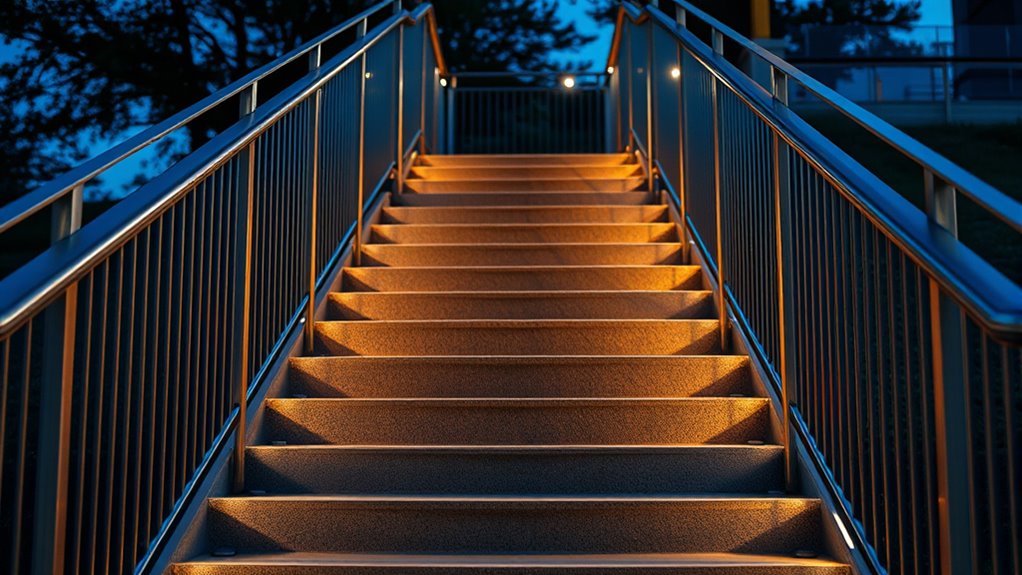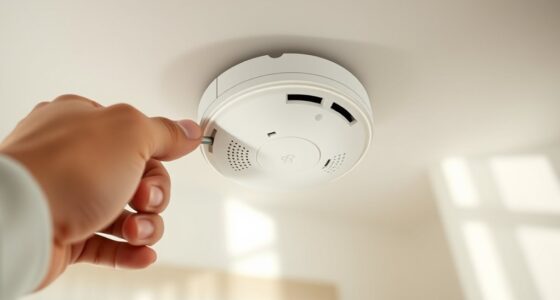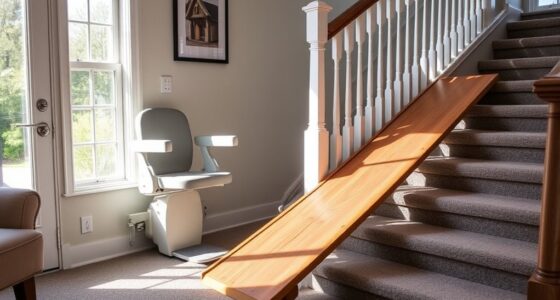To keep your outdoor steps, railings, and lighting safe and effective, regularly inspect and maintain them. Make certain steps have non-slip surfaces, are well-lit, and free of debris or ice. Use sturdy, weather-resistant railings that are securely attached. Add proper outdoor lighting along walkways and steps to improve visibility at night. Maintaining these features protects you from falls and enhances your home’s curb appeal—keep going to discover more ways to boost outdoor safety and durability.
Key Takeaways
- Regularly inspect and maintain steps to ensure they are sturdy, slip-resistant, and free of debris or damage.
- Install durable, weather-resistant railings that are securely anchored and regularly checked for stability.
- Use proper outdoor lighting, such as solar lamps and motion sensors, to illuminate walkways and entrances for safety and security.
- Keep outdoor areas clear of hazards, and apply slip-resistant coatings on steps for added safety.
- Ensure consistent step heights and adequate lighting to prevent trips and falls, enhancing overall outdoor safety.
Ensuring Safe and Accessible Steps
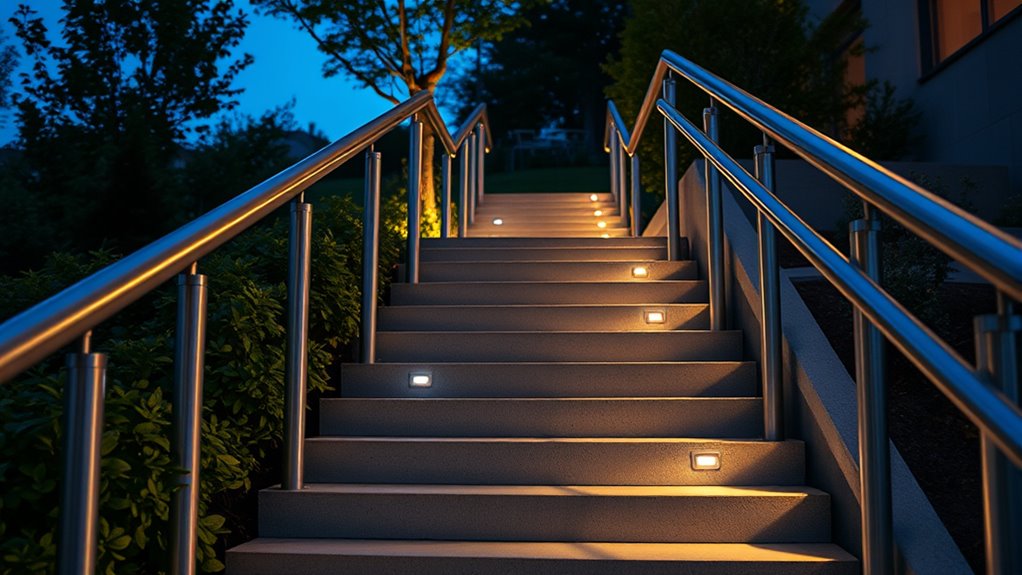
To guarantee your outdoor steps are safe and accessible, start by inspecting them regularly for damage or wear. Check that the surfaces have non-slip features to prevent slips, especially in wet conditions. Ensuring each step has a consistent height is vital; uneven steps can cause trips and falls. Use a level to verify step height consistency and make adjustments if needed. Consider applying slip-resistant coatings or adding textured mats to improve traction. Keep the steps clear of debris, ice, or snow to reduce hazards. Proper lighting can also highlight potential issues and make steps more visible at night. Regular maintenance and vigilant inspections will help keep your outdoor steps safe, accessible, and secure for everyone. Additionally, understanding air quality and proper ventilation can prevent moisture buildup and mold growth that may compromise step safety over time.
Installing and Maintaining Sturdy Railings
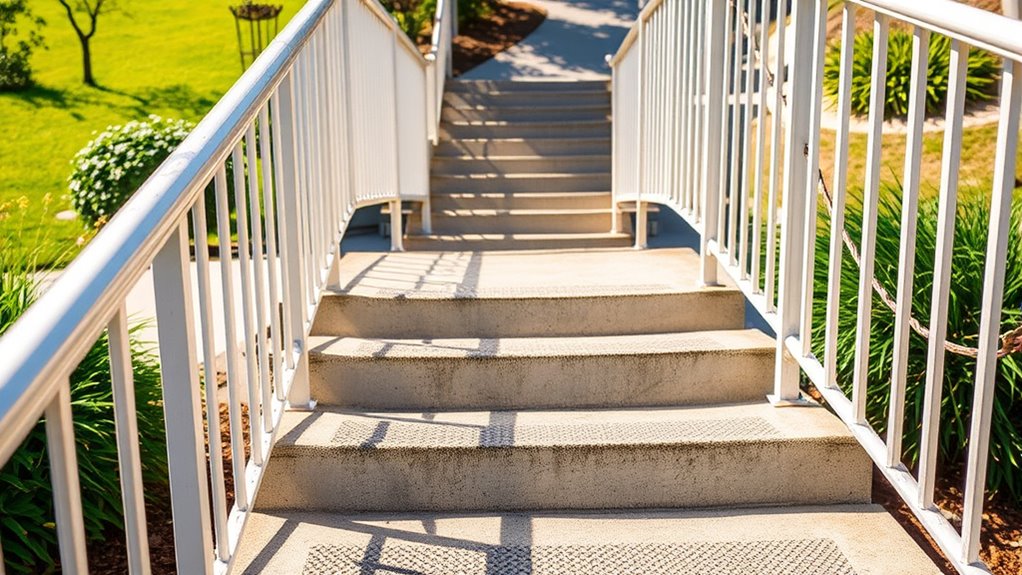
Installing sturdy railings alongside your outdoor steps provides critical support and stability. Choose materials with high durability like treated wood, metal, or composite to withstand weather and daily use. Railing design is also essential; it should be comfortable to grip, aesthetically pleasing, and compliant with safety standards. Regular maintenance keeps your railings secure and attractive—tighten loose fittings, clean off debris, and inspect for rust or rot. Properly installed railings can prevent falls and give you peace of mind. Additionally, selecting materials with high weather resistance can extend the lifespan of your railings and reduce maintenance needs. Remember, strong material durability and thoughtful railing design not only protect your loved ones but also enhance your home’s curb appeal. Don’t overlook these details—invest in quality, and your outdoor space will remain safe and inviting for years.
Enhancing Visibility With Proper Outdoor Lighting
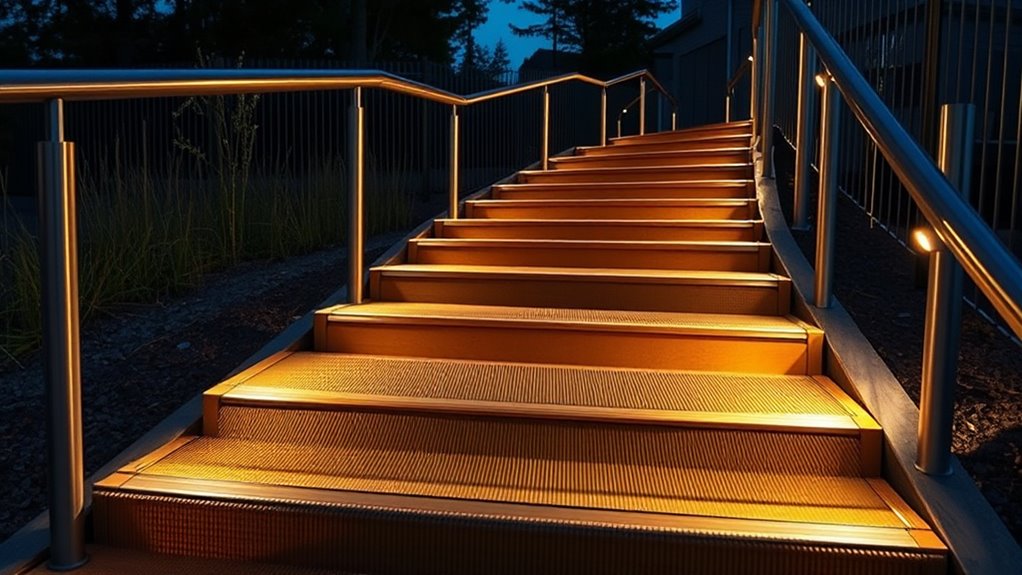
Proper outdoor lighting is essential for safety and security around your home. It helps you see hazards, deters intruders, and creates a welcoming atmosphere. Solar lamps are a convenient option; they automatically charge during the day and turn on at dusk. Motion sensors add an extra layer of security by activating lights only when movement is detected, conserving energy and illuminating unexpected activity. To maximize effectiveness, consider placing lights along walkways, near entrances, and around dark corners. Here’s a quick guide:
| Lighting Type | Placement | Benefits |
|---|---|---|
| Solar Lamps | Pathways, garden edges | Easy to install, eco-friendly |
| Motion Sensors | Entrances, driveways | Detects movement, saves energy |
| Fixed Lights | Porch, steps | Consistent illumination |
In addition, Kia Tuning options can enhance the aesthetic appeal of your outdoor space through custom modifications. Proper lighting enhances safety, visibility, and peace of mind.
Frequently Asked Questions
What Materials Are Best for Outdoor Steps in Harsh Weather?
For harsh weather, you should choose outdoor step materials that are weather-resistant and feature non-slip surfaces. Concrete with textured finishes or treated stone work well because they withstand rain, snow, and ice. Composite materials and treated wood with anti-slip coatings also perform reliably. These options guarantee your steps remain safe and durable, providing good traction and resisting damage from the elements, so you can feel confident walking outdoors year-round.
How Do I Choose the Right Height for Outdoor Railings?
You should choose a balcony railing height that meets local building codes, typically around 42 inches for decks. Measure your deck height accurately, and make certain the railing is high enough to prevent falls but comfortable to lean on. Consider the overall design and safety standards to select a railing that provides adequate protection while complementing your space. Proper height enhances safety and complies with regulations, giving you peace of mind.
What Are the Recommended Outdoor Lighting Types for Safety?
You should choose landscape illumination and pathway lighting that are bright enough to clearly define walkways and outdoor areas. Opt for LED lights for energy efficiency and durability, and consider fixtures with motion sensors for added safety. Use low-level pathway lights to prevent tripping hazards, and install higher lights near stairs and entrances to improve visibility. Proper outdoor lighting creates a safer environment and enhances your outdoor space’s appearance.
How Often Should Outdoor Lighting Fixtures Be Inspected and Replaced?
Did you know that poorly maintained outdoor lighting can increase accidents by 50%? You should inspect your fixtures at least quarterly, following a regular timing schedule. During your maintenance checklist, check for flickering bulbs, corrosion, or damage. Replace bulbs or fixtures immediately when issues arise to guarantee safety. Regular inspections and timely replacements keep your outdoor space well-lit, safe, and welcoming for everyone.
Are There Specific Regulations for Outdoor Safety Features in Residential Areas?
Yes, there are specific regulations for outdoor safety features in residential areas. You should follow local building codes and safety standards, which outline requirements for handrails, step dimensions, lighting, and railing heights. These regulations guarantee your outdoor spaces are safe and compliant. Always check with your local authority or building department to confirm the latest codes, and ensure your outdoor safety features meet all necessary standards to prevent accidents.
Conclusion
By prioritizing safe steps, sturdy railings, and proper lighting, you transform your outdoor space into a fortress of safety. Imagine your home glowing brightly like a lighthouse, guiding every visitor safely. These simple yet powerful measures prevent accidents and make your outdoor areas inviting and secure. Don’t wait for a mishap—take action now and turn your yard into a safe haven that shines brighter than the stars themselves!
